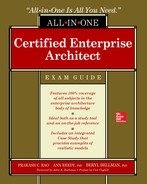Book Description
This effective study guide offers comprehensive coverage of topics comprising the enterprise architecture body of knowledge. The book provides detailed coverage and lays out actionable methodologies and best practices to create and maintain successful EA models, artifacts and building blocks. It helps prepare readers to take any of the various EA certification exams and academic courses in enterprise architecture.
This highly effective self-study guide offers comprehensive coverage of all topics in the enterprise architecture body of knowledge. Written by a team of experienced academics, practitioners, and professionals, the book takes a holistic look at the practice of enterprise architecture. You will get actionable methodologies and best practices and learn how to develop, deploy, and maintain successful enterprise architecture models, artifacts, and building blocks. Designed to help you prepare for certification, the Certified Enterprise Architect All-in-One Exam Guide also serves as an essential on-the-job reference.
Coverage includes:
•Enterprise architecture foundation concepts
•Planning the enterprise architecture
•Enterprise architecture development, governance, and maintenance
•Defense frameworks
•Viewpoints and views
•The Zachman Framework
•The Open Group Architecture Framework (TOGAF)
•The Common Approach to Federal Enterprise Architecture
•FEAF2
•Comparison of frameworks
•Case Study integrated throughout the text
•And much more
